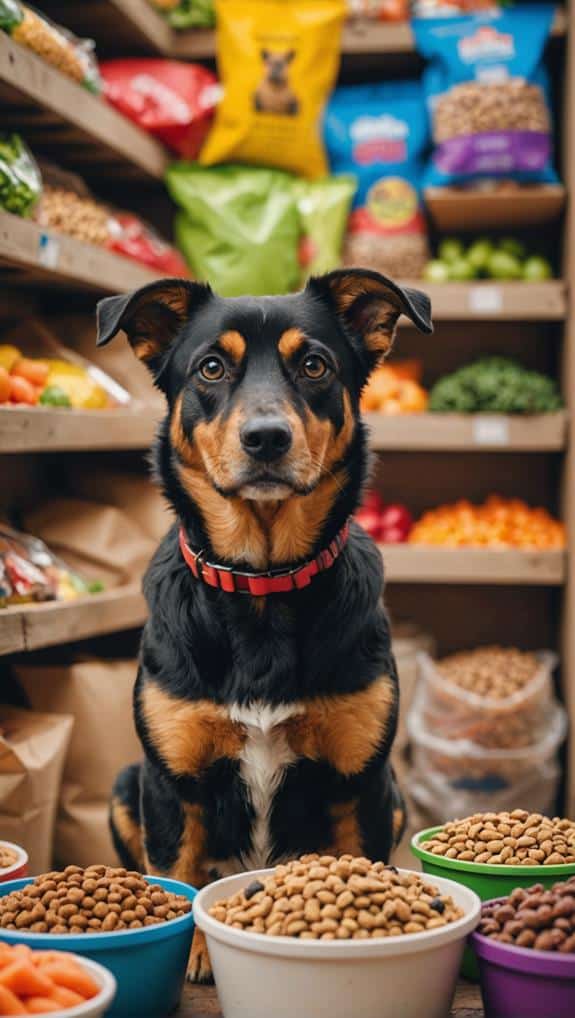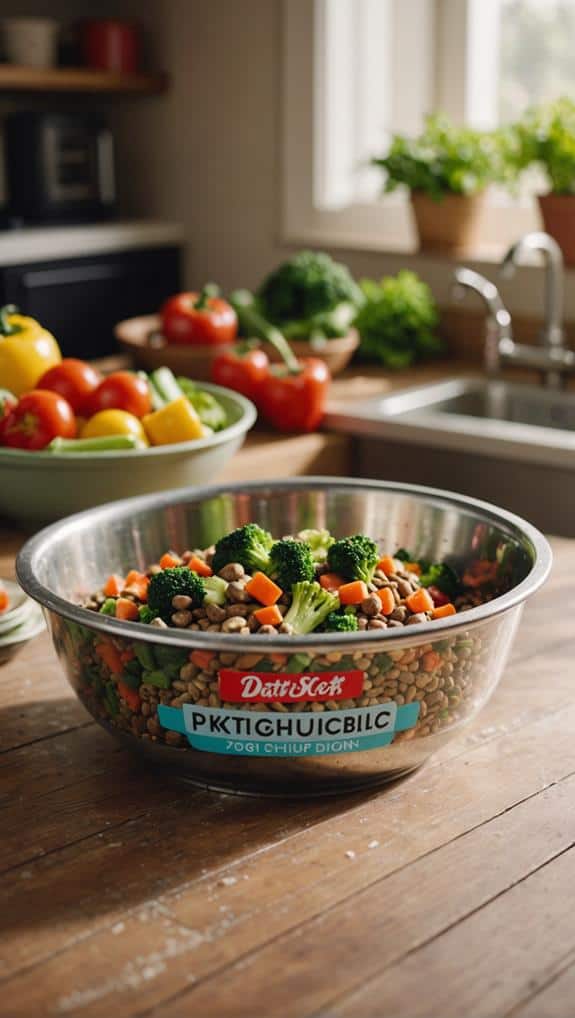Imagine you suddenly switch from your favorite comfort food to a completely different cuisine; it might not sit well with you, and the same goes for your pet. Abrupt dietary changes can lead to gastrointestinal distress, leaving your furry friend feeling unwell. You might think a new brand or flavor is the answer to your pet's mealtime boredom, but without a careful changeover, you could be setting the stage for a host of issues. So, how can you guarantee a smooth switch that won't upset their stomach?
Contents
Common Nutrition Mistakes

When you decide to switch your dog's food, it's important to do so gradually; otherwise, you risk gastrointestinal distress, which can manifest as diarrhea or vomiting.
Many pet owners mistakenly make abrupt food changes, ignoring the adjustment period necessary for their dog's digestive health. A balanced diet is essential for overall well-being, and just like with a high-fiber diet for bunnies, ensuring a proper adjustment can help prevent digestive issues.
For dogs with sensitive stomachs, this gradual approach is even more important, as they may react poorly to sudden alterations in their diet.
Another common nutrition mistake is assuming that any food labeled "premium" or "natural" automatically meets your dog's nutritional needs.
Always check that the food adheres to AAFCO guidelines for a complete and balanced diet. Tailoring your dog's diet to their specific health profile is critical, especially if they've allergies or sensitivities.
Additionally, don't overlook portion sizes. Even high-quality food can lead to obesity and related health issues if calorie intake is excessive.
Monitoring your dog's stool quality is also important; while minor variations might be normal, consistent abnormalities could indicate deeper digestive problems that warrant veterinary attention.
The Importance of Gradual Transitions
Gradually changing your dog's food is essential for maintaining their digestive health and overall well-being. Abrupt changes can lead to gastrointestinal upset, causing symptoms like vomiting, diarrhea, and reduced appetite.
To prevent these issues, aim for a gradual adjustment over 5-7 days. Start with 25% new food mixed with 75% old food on Day 1, and by Day 7, your dog should be enjoying 100% of the new diet.
It's important to tailor this process to your dog's individual needs, especially if they're sensitive. Some dogs may require a longer adjustment period, so pay close attention to their reactions.
During this time, monitor their digestive health, stool quality, and overall behavior. Keeping a close eye on these factors will help you gauge how well your dog is adjusting.
If you notice any persistent issues, don't hesitate to consult your veterinarian for guidance.
Implementing gradual adjustments not only maintains digestive stability but also minimizes stress on your dog's system, increasing the likelihood of a successful switch to a nutritious diet. Your care and attention can make all the difference in your pet's health.
Signs of Dietary Sensitivity

When your dog shows signs of dietary sensitivity, it's important to pay attention to symptoms like nausea, vomiting, or persistent diarrhea.
You might also notice skin irritations such as itching or hair loss, which can indicate a reaction to certain foods.
Monitoring these signs closely can help you identify potential food intolerances and decide if an elimination diet is necessary.
Common Symptoms to Watch
Dietary sensitivity in dogs can manifest through various symptoms that you should closely monitor. One of the most common indicators is gastrointestinal upset, which can include nausea, vomiting, diarrhea, and changes in appetite. These digestive problems often arise from abrupt changes in diet, emphasizing the significance of a gradual shift when you change your dog's food.
Additionally, keep an eye out for skin reactions like itching, inflammation, or hair loss, which may suggest food allergies or intolerances. While true food allergies are rare, many dogs experience adverse reactions that can be mistaken for them.
Monitoring your dog's stool quality is essential; if you notice loose stools or lower fecal scores (1-2), this could signal gastrointestinal distress. Higher scores (5-6) indicate a more severe dietary intolerance that requires attention.
To minimize these risks, aim for a ten-day gradual shift when introducing new food. Following specific day-to-day ratios can greatly reduce the likelihood of adverse reactions.
Recognizing Food Intolerance Signs
Recognizing the signs of food intolerance in your dog is necessary for maintaining their health and well-being. Food intolerance often manifests through gastrointestinal symptoms like nausea, vomiting, diarrhea, or bloating, especially after changing their diet. These reactions indicate an underlying sensitivity that you shouldn't ignore.
Additionally, watch for cutaneous signs such as itching, inflammation, or hair loss, which may suggest food allergies or intolerances. Understanding your pet's body language and behavior can also provide insights into their emotional and physical state, helping to identify potential issues related to diet recognizing signs of happiness.
Monitoring your dog's response to food changes is important, as adverse reactions can take time to surface. An eight-week elimination diet trial often helps identify problematic ingredients. Persistent gastrointestinal distress, like diarrhea lasting more than a few days, is a clear sign you should consult your veterinarian to rule out food intolerances or other health issues.
Fecal consistency and overall stool quality are also significant indicators of dietary tolerance. If your dog's stool scores fall outside the ideal range of 3-4, it's necessary to evaluate for potential food sensitivities.
Monitoring Digestive Health
Monitoring your pet's digestive health is essential, especially after a food switch. Pay close attention to their stool quality, as changes in frequency or consistency can signal distress that needs your immediate attention.
It’s important to remember that rabbits lack a natural fullness signal, which can lead to overeating and subsequent digestive issues if not monitored closely. Keeping an eye on signs of overeating will help guarantee your pet remains healthy and comfortable during this change. To promote a balanced diet, provide your rabbit with a variety of fresh hay, vegetables, and limited pellets to ensure they receive the necessary nutrients without overindulging. Additionally, implementing a regular feeding schedule can help regulate their eating habits and prevent binge eating. For more guidance, consider following optimal rabbit digestive health tips to keep your furry friend thriving and content.
Signs of Digestive Distress
Keeping an eye on your dog's digestive health is essential for their overall well-being. You should be vigilant for signs of digestive distress, especially when altering your dog's diet. Symptoms like an upset stomach can manifest as nausea, vomiting, or diarrhea.
If you notice sudden changes in stool consistency or color, this could indicate gastrointestinal issues that require attention. Minor variations are normal, but significant changes should prompt you to consult your veterinarian.
When adapting to a new diet, it's common for dogs to experience temporary digestive upset, often resulting in diarrhea that lasts about 3 to 4 days if changes aren't implemented gradually.
However, if gastrointestinal symptoms persist beyond a week or if stool quality is consistently abnormal, it's vital to seek veterinary assessment. These symptoms may also be linked to adverse food reactions, which can lead to further complications if left unaddressed.
Importance of Stool Monitoring
Regularly checking your dog's stool is essential for evaluating their digestive health and overall well-being. Monitoring stool quality provides critical insights into how well your dog is adapting to any dietary changes.
Significant shifts in color, consistency, or frequency can signal underlying issues that might arise from a new food. According to the Fecal Scoring Chart, ideal stool scores range from 3 to 4. Scores below this range may indicate dehydration or constipation, while higher scores could suggest gastrointestinal upset.
By observing your dog's stool regularly, you can identify adverse reactions to new foods, such as diarrhea or vomiting, which warrant further evaluation. A gradual shift to new dog food is important to minimize stress on their digestive system.
Consistent stool monitoring during this adjustment period is essential for early detection of any adverse reactions. If you notice any abnormal stool quality persisting beyond a week, it's important to consult a veterinary professional. They can help rule out gastrointestinal diseases or food allergies, ensuring your furry friend stays healthy and happy.
Your proactive approach to monitoring their stool can make a significant difference in their digestive health.
The Role of Quality Ingredients

When it comes to your dog's health, the quality of ingredients in their food plays an essential role. Choosing nutrient-rich options is critical for maintaining overall health and energy levels, especially for active breeds. High-quality dog foods typically contain around 30% protein, which is ideal for supporting your dog's well-being.
Ingredients rich in Omega-3 and Omega-6 fatty acids are particularly beneficial, promoting skin health and improving coat condition. This can lead to a reduction in itchiness after a food switch, enhancing your pet's comfort and well-being.
Additionally, selecting appropriate ingredients is crucial for dogs with sensitivities; grain-free diets may be necessary for specific breeds, highlighting how quality directly impacts digestion and overall health.
Regularly monitoring the ingredients in your dog's diet allows you to identify potential allergens or intolerances, helping you prevent adverse reactions that could complicate their health. The presence of high-quality, nutrient-rich ingredients can also improve digestion, leading to firmer stools and less gas.
This not only positively affects your dog's energy levels but also contributes to their overall well-being and happiness. Prioritize quality ingredients for your beloved furry friend.
Recognizing Adverse Reactions
Noticing changes in your dog's behavior or health after switching their food is vital for identifying potential adverse reactions. These reactions can manifest as gastrointestinal issues, including nausea, vomiting, and diarrhea, or as cutaneous symptoms like itching and hair loss.
While true food allergies are rare, many dogs experience food intolerances or sensitivities, requiring careful observation to differentiate between the two.
To effectively monitor your dog's response, keep a close eye on their stool quality. Consistent changes in consistency or color can indicate gastrointestinal upset or other health concerns related to the new diet. If you suspect food intolerances, consider conducting an elimination diet trial over at least eight weeks to pinpoint the specific ingredient causing the issue.
Should your dog show persistent adverse reactions after changing their food, it's essential to consult a veterinarian. They can help identify and address any underlying health issues or dietary intolerances.
Your vigilance and proactive approach won't only support your pet's well-being but also guarantee they thrive on their new diet. Remember, your dog's health is paramount, and recognizing these signs early can lead to a happier, healthier life.
Adjusting to New Food

A gradual shift to new dog food is essential for ensuring your pet's digestive comfort and overall well-being. When adjusting to new food, it's important to follow a 5-7 day changeover period.
Start by mixing a small amount of the new food with your dog's current diet, slowly increasing the new food's proportion each day. Abrupt changes can cause gastrointestinal upset, leading to symptoms like vomiting, diarrhea, and loss of appetite, which can be distressing for both you and your dog.
During this changeover, closely monitor your dog's behavior and stool consistency. Any significant changes in stool quality may indicate dietary intolerance or upset.
Dogs with sensitivities might require a longer adjustment period, highlighting the need for a personalized approach based on their individual needs.
Stay observant during this time; any adverse reactions could necessitate consulting your veterinarian.
Remember, a thoughtful and gradual changeover can make a significant difference in your dog's comfort and health, ensuring they adapt well to their new food without unnecessary stress.
Your attentiveness during this period sets the stage for a happier, healthier pet.
Feeding Strategies for Picky Eaters
Many dog owners face the challenge of dealing with picky eaters, which can be frustrating and concerning.
To help your dog adjust to a new diet, implement strict feeding times by limiting food exposure to a 15-20 minute window. This strategy encourages your dog to eat when food is offered and can reduce picky eating behaviors. Gradually introduce new foods by mixing them with familiar options or using enticing toppers to enhance palatability.
Consider occasionally implementing "fast days," where you feed your dog less to renew their appetite for regular meals. Smaller, more frequent feeding times can also help manage pickiness. Avoid providing 24/7 access to food, as this may lead to grazing behavior and exacerbate pickiness.
It's essential to observe your dog's preferences for certain textures or ingredients. Reinforcing positive feeding behaviors can enhance their acceptance of food over time.
Consulting Your Veterinarian

Before making any changes to your dog's diet, it's vital to consult your veterinarian. They can help you determine if the new food is nutritionally appropriate for your pet's specific needs. This is especially important for puppies, who need fundamental nutrients for growth and development.
Your veterinarian can provide valuable advice on how to implement a gradual change to the new diet, which helps minimize the risk of gastrointestinal upset. Abrupt changes can lead to digestive issues, so taking it slow is key.
If your dog experiences gastrointestinal problems that last more than a week after the switch, seeking veterinary consultation is significant to rule out underlying health concerns or food intolerances.
Keeping track of your dog's response to the new food, including any changes in stool quality and appetite, can also aid your veterinarian in diagnosing potential issues.
Regular veterinary check-ups allow for ongoing dietary adjustments based on your dog's changing health needs, helping to prevent complications related to food switches. Prioritizing your dog's health through professional guidance guarantees their diet supports their overall well-being.
Final Thoughts
When switching your pet's food, remember that a sudden change can be like throwing a wrench in a well-oiled machine, causing digestive chaos. By shifting gradually and keeping an eye on their health, you can help guarantee a smooth adjustment. Stay alert for any signs of sensitivity, and consult your veterinarian to navigate this process safely. Your furry friend deserves a diet that keeps them happy and healthy, so take the time to make the switch right.






